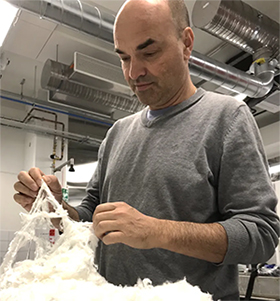“I don't think I could have gotten the help I received from RISE in Örnsköldsvik anywhere else in the world,” says Gary Cass, founder of Cass Materials.
In 2006, he stunned the fashion world with a dress made of red wine. Now he wants to make the packaging industry more sustainable, with foams made from residual materials from the forest and paper industry.
 Gary CassGary Cass hails from Perth, Australia, and has a background in agricultural sciences, with a bachelor’s degree in horticulture and a microbiology specialisation. In 2006, he attracted plenty of attention as the first person in the world to create a dress from wine – or more precisely, from winemaking by-products.
Gary CassGary Cass hails from Perth, Australia, and has a background in agricultural sciences, with a bachelor’s degree in horticulture and a microbiology specialisation. In 2006, he attracted plenty of attention as the first person in the world to create a dress from wine – or more precisely, from winemaking by-products.
Cass wanted to be part of transforming the textile industry from a past rooted in industrialisation to a future of environmental adaptation.
”In the beginning, it was a narrow art project. But to step it up, we had to transform it to a commercial scale”
“That was when I first came into contact with RISE in Örnsköldsvik, which I’ve now benefited greatly from as I develop what is today my main focus: foams based on nanocellulose.”
Huge business potential
At the outset, the goal was to use the foam as an absorbent in products like diapers. But then Cass and RISE discovered that packaging shows much greater business potential. The foam can be used as a more sustainable alternative to polystyrene in packaging. Besides the fact that the foam is created entirely from biomaterial, it is insulating and fire-resistant.
“I learned that there are residual products from the forest and paper industry that we could use as feedstocks, and that changed the game plan completely. We were able to add value to a waste product that otherwise risked ending up in landfill. Now we can revolutionise the packaging industry by creating value-added products while solving a waste problem for the forest and paper industry.”
Relocation to Örnsköldsvik
To demonstrate his wholehearted commitment and enable development of the innovation together with RISE, Cass moved to Örnsköldsvik in 2022 and launched his company Cass Materials AB. At RISE, he gained access to laboratories and all the resources he needed.
“They have some fantastic laboratories here, and it’s extraordinary to get access to all this equipment and expertise. I’m really humbled by the reception I’ve had here and the commitment I’ve encountered, from management to the researchers and lab staff. There’s always someone who has a solution to overcoming the obstacles we encounter, and in the past year, my technology has evolved in a way that it would not have done if I had stayed in Australia.”
Local production on a local market
The company’s business strategy is to have the foam production close to the factories in Europe that have the residual streams that become feedstocks. This brings two advantages. The products can be produced both near the raw materials and near the market for the final products.
“We utilise materials that would otherwise be disposed of as waste while minimising transport,” Cass says. “What we need now is major investment so we can scale up. We’ve got a good grasp of the technology. My goal is to have a pilot factory at Domsjö Fabriker by the end of the year. They have residual streams that I can use as feedstocks for the foam.”
Source: RISE













